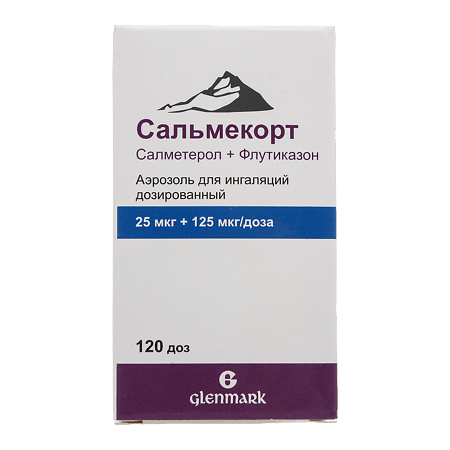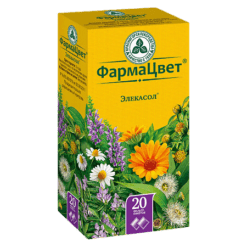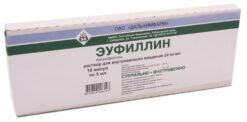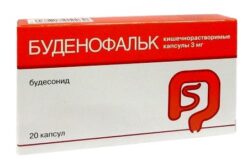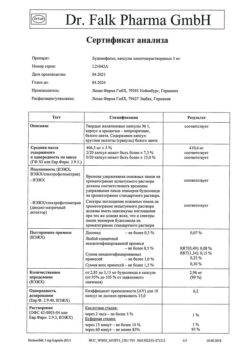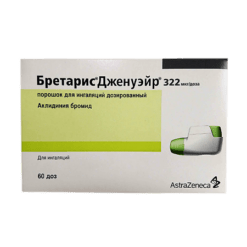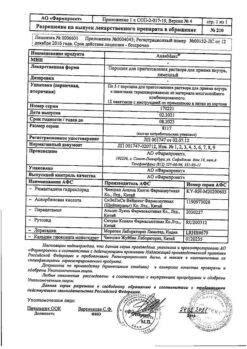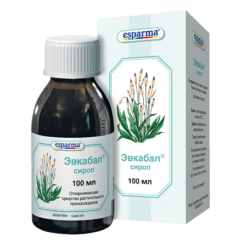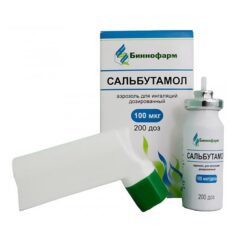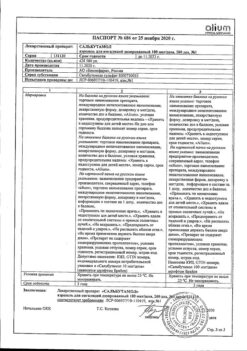No products in the cart.
Salmecort, aerosol 25 mcg+125 mcg/dose 120 doses
€22.84 €19.03
Description
Salmecort is a combined bronchodilator (contains salmeterol and fluticasone propionate). Salmeterol is a selective agonist of beta2-adrenoreceptors with prolonged action (at least 12 hours). Salmeterol molecule has a long side chain that binds to the outer domain of the receptor.
Due to these pharmacological properties, salmeterol is more effective to prevent histamine-induced bronchospasm and causes more prolonged bronchodilation compared to conventional short acting beta2-receptor agonists. Effectively and long-lasting inhibits the release of mast cell mediators such as histamine, leukotrienes and PgD2 in the lung tissue.
Suppresses early and late stage of allergic reaction; after administration of a single dose bronchial hyperresponsiveness decreases, inhibition of the late stage persists for over 30 h after a single dose, when the bronchodilator effect is no longer.
Fluticasone propionate is a glucocorticosteroid (GCS) of local action. When administered by inhalation in recommended doses it produces evident anti-inflammatory and anti-allergic effect leading to reduction of symptoms and frequency of exacerbations of diseases accompanied by airway obstruction.
During long-term use of inhaled fluticasone propionate at maximum doses, daily and reserve secretion of adrenal cortex hormones remains within normal limits in adults and children. A residual decrease in reserve adrenal function may persist long after therapy.
Pharmacokinetics
There is no evidence that co-administration of salmeterol and fluticasone propionate by inhalation affects the pharmacokinetics of either substance.
Salmeterol: After inhalation administration at therapeutic doses, very low plasma concentrations of the drug are produced (200 pg/ml or less). With regular use of inhaled salmeterol, hydroxynaphthoic acid is detected in the systemic bloodstream in concentrations up to 100 ng/ml.
Fluticasone propionate: after inhalation relative bioavailability is 10 to 30%, depending on the drug delivery system. Systemic absorption occurs primarily in the lungs. Part of the inhaled dose may be swallowed, but its systemic effect is minimal due to the weak water solubility of the drug and intense metabolism during “first passage” through the liver.
The bioavailability of fluticasone when swallowed is less than 1%. There is a direct correlation between the magnitude of the inhaled dose and the systemic effect of fluticasone; the volume of distribution is about 300L. It is metabolized in the liver to an inactive metabolite involving CYP3A4 of the cytochrome P450 system. Less than 5% of the metabolite is excreted in the urine. Plasma clearance is 1.15 l/min. The elimination half-life T1/2 is about 8 hours.
Indications
Indications
The drug Salmecort is intended for the regular treatment of bronchial asthma in patients who are indicated for combination therapy with a long-acting beta2-adrenergic agonist and an inhaled glucocorticosteroid:
in patients with insufficient disease control on the background of constant monotherapy with inhaled glucocorticosteroids with periodic use of a short-acting beta2-adrenergic agonist;
in patients with adequate disease control during therapy with an inhaled glucocorticosteroid and a long-acting beta2-adrenergic agonist;
as initial maintenance therapy in patients with persistent bronchial asthma (daily occurrence of symptoms, daily use of drugs for rapid relief of symptoms) if there are indications for prescribing glucocorticosteroids to achieve disease control;
Maintenance therapy in patients with COPD whose forced expiratory volume (FEV1) is <60% of predicted values (before inhalation of a bronchodilator) with a history of repeated exacerbations, and in whom severe symptoms of the disease persist despite regular bronchodilator therapy.
Pharmacological effect
Pharmacological effect
Salmecort is a combined bronchodilator (contains salmeterol and fluticasone propionate). Salmeterol is a selective long-acting beta2-adrenergic receptor agonist (at least 12 hours). The salmeterol molecule has a long side chain that binds to the outer domain of the receptor.
Due to these pharmacological properties, salmeterol is more effective in preventing histamine-induced bronchospasm and causes longer-lasting bronchodilation compared to conventional short-acting beta2-agonists. Effectively and for a long time inhibits the release of mast cell mediators such as histamine, leukotrienes and PgD2 in lung tissues.
Suppresses the early and late stages of an allergic reaction; after administration of a single dose, bronchial hyperreactivity decreases, late-stage inhibition persists for more than 30 hours after administration of a single dose, when the bronchodilator effect is no longer present.
Fluticasone propionate is a local glucocorticosteroid (GCS). When inhaled in recommended doses, it has a pronounced anti-inflammatory and antiallergic effect, which leads to a decrease in the severity of symptoms and a decrease in the frequency of exacerbations of diseases accompanied by airway obstruction.
With long-term use of inhaled fluticasone propionate in maximum doses, the daily and reserve secretion of adrenal hormones remains within normal limits in adults and children. Residual decrease in adrenal reserve function may persist for a long time after therapy.
Pharmacokinetics
There is no evidence that coadministration of inhaled salmeterol and fluticasone propionate affects the pharmacokinetics of either substance.
Salmeterol: after inhalation administration in therapeutic doses, very low concentrations of the drug in the blood plasma are created (200 pg/ml or less). With regular use of inhaled salmeterol, hydroxynaphthoic acid is detected in the systemic circulation in concentrations of up to 100 ng/ml.
Fluticasone propionate: after inhalation administration, the relative bioavailability ranges from 10 to 30% depending on the drug delivery system. Systemic absorption occurs primarily in the lungs. Part of the inhaled dose can be swallowed, but its systemic effect is minimal due to the drug’s poor solubility in water and intensive “first pass” metabolism through the liver.
The bioavailability of fluticasone when swallowed is less than 1%. There is a direct relationship between the size of the inhaled dose and the systemic effect of fluticasone; the volume of distribution is about 300 l. Metabolized in the liver to an inactive metabolite with the participation of CYP3A4 of the cytochrome P450 system. Less than 5% of the metabolite is excreted in the urine. Plasma clearance is 1.15 l/min. The half-life T1/2 is about 8 hours.
Special instructions
Special instructions
Salmecort is not intended for the relief of acute symptoms, since in such cases a rapid and short-acting inhaled bronchodilator (for example, salbutamol) should be used. Patients should be advised to always have medication available to relieve acute symptoms.
The combination of salmeterol and fluticasone propionate can be used for initial maintenance therapy in patients with persistent bronchial asthma (daily onset of symptoms or daily use of drugs to relieve attacks) if there are indications for the use of GCS and when determining their approximate dosage.
More frequent use of short-acting bronchodilators to relieve symptoms indicates deterioration of disease control, and in such situations the patient should consult a doctor.
A sudden and increasing deterioration in asthma control is potentially life-threatening, and in such situations the patient should also consult a doctor. The physician should consider a higher dose of GCS. If the dose of Salmecort used does not provide adequate control of the disease, the patient should also consult a doctor.
Patients with asthma should not sharply reduce treatment with Salmecort due to the risk of exacerbation; the dose of the drug should be reduced gradually under the supervision of a physician. In patients with COPD, drug withdrawal may be accompanied by symptoms of decompensation and requires medical supervision.
In patients with COPD receiving Salmecort, the incidence of pneumonia may increase (see section “Side effects”). Clinicians should be aware of the possibility of pneumonia in patients with COPD, since the clinical presentation of exacerbation of COPD and pneumonia are often similar.
Any inhaled GCS can cause systemic reactions, especially with long-term use in high doses; however, the likelihood of such symptoms occurring is much lower than with treatment with oral corticosteroids (see section “Overdose”). Possible systemic reactions include Cushing’s syndrome, Cushingoid features, adrenal suppression, growth retardation in children and adolescents, decreased bone mineral density, cataracts, and glaucoma.
Therefore, when treating asthma, it is important to reduce the dose to the lowest dose that provides effective control of the disease.
In emergency and planned situations that can cause stress, you must always remember the possibility of suppressing adrenal function and be prepared to use GCS (see section “Overdose”).
When carrying out resuscitation measures or surgical interventions, it is necessary to determine the degree of adrenal insufficiency. It is recommended to regularly measure the height of children who receive long-term therapy with inhaled corticosteroids.
Due to the possibility of adrenal suppression, patients switched from oral corticosteroids to inhaled fluticasone propionate therapy should be treated with extreme caution and their adrenal function regularly monitored.
When transferring patients from taking systemic corticosteroids to inhalation therapy, allergic reactions (for example, allergic rhinitis, eczema), which were previously suppressed by systemic corticosteroids, may occur. In such situations, it is recommended to carry out symptomatic treatment with antihistamines and/or topical drugs, including corticosteroids for topical use.
After starting treatment with inhaled fluticasone propionate, systemic corticosteroids should be withdrawn gradually, and such patients should have a special patient card containing an indication of the possible need for additional administration of corticosteroids in stressful situations.
In patients with exacerbation of bronchial asthma, hypoxia, it is necessary to control the concentration of potassium ions K+ in plasma.
There are very rare reports of increased blood glucose levels, and this should be remembered when prescribing a combination of salmeterol with fluticasone propionate to patients with diabetes mellitus (see section “Side effects”).
Due to the potential for systemic effects of GCS, including Cushing’s syndrome and adrenal suppression, the combined use of fluticasone propionate and ritonavir should be avoided unless the potential benefit to the patient outweighs the risk associated with the systemic effects of GCS (see section “Interactions with other drugs”).
When taking salmeterol, the risk of serious respiratory adverse reactions or death in African-American patients is believed to be higher than in other patients. The significance of pharmacogenetic factors or other causes is unknown. The effect of concomitant use of inhaled corticosteroids on the risk of death in patients with asthma has not been studied.
Like other inhaled drugs, Salmecort can cause paradoxical bronchospasm, manifested by an increase in shortness of breath immediately after use.
In this case, you should immediately use a fast- and short-acting inhaled bronchodilator, discontinue Salmecort and, if necessary, begin alternative therapy (see section “Side effects”).
Adverse reactions associated with the pharmacological action of beta2 antagonists, such as tremor, subjective palpitations and headache, may occur. However, these reactions are short-term in nature, and their severity decreases with regular therapy (see section “Side effects”).
Impact on the ability to drive vehicles. Wed and fur.:
In clinical studies, no data were obtained on the effect of the drug on the ability to drive vehicles and other mechanisms, however, the side effects that the drug may cause should be taken into account.
Active ingredient
Active ingredient
Salmeterol, Fluticasone
Composition
Composition
Aerosol for inhalation dosed
Pregnancy
Pregnancy
Pregnant and lactating women should be prescribed the drug only if the expected benefit to the mother outweighs any possible risk to the fetus or child. There is insufficient data on the use of salmeterol and fluticasone propionate during pregnancy and lactation.
Pregnancy
Excessive systemic concentrations of active beta2-adrenergic agonists and corticosteroids have an effect on the fetus.
Extensive clinical experience with drugs of this class indicates that when using therapeutic doses, the described effects are not clinically significant. Salmeterol and fluticasone propionate are not genotoxic.
Lactation
The concentration of salmeterol and fluticasone propionate in the blood plasma after inhalation of the drug in therapeutic doses is extremely low, so their concentration in breast milk should be equally low. There are no data on the concentrations of salmeterol and fluticasone propionate in the breast milk of women during lactation.
Contraindications
Contraindications
Hypersensitivity to one or more components of the drug,
children’s age (up to 4 years).
With caution:
Like all other inhaled drugs containing corticosteroids, Salmecort should be used with caution in patients with acute or latent pulmonary tuberculosis, fungal, viral or bacterial infections of the respiratory system, and thyrotoxicosis.
When taking any drugs from the sympathomimetic group, especially when therapeutic doses are exceeded, the development of cardiovascular phenomena such as an increase in systolic blood pressure and heart rate is possible. For this reason, Salmecort should be prescribed with caution to patients suffering from cardiovascular diseases, including arrhythmias such as supraventricular tachycardia and extrasystole, ventricular extrasystole, atrial fibrillation.
All sympathomimetic drugs in dosages exceeding therapeutic ones can cause a transient decrease in serum potassium levels, so Salmecort should be prescribed with caution to patients with hypokalemia. Any inhaled GCS can cause systemic effects, especially with long-term use in high doses, so the drug should be used with caution in case of glaucoma, cataracts, osteoporosis (see section “Special instructions and precautions for use”).
There are very rare reports of increased blood glucose levels, so patients with diabetes mellitus should use Salmecort with caution (see section “Side effects”).
Side Effects
Side Effects
All undesirable reactions presented below are characteristic of the active ingredients – salmeterol and fluticasone propionate separately. The safety profile of the drug Salmecort does not differ from the profile of adverse reactions of its active substances.
The adverse reactions presented below are listed according to the damage to organs and organ systems and the frequency of occurrence. The frequency of occurrence is determined as follows: very common (>1/10), common (>1/100 and 1/1000 and 1/10000 and <1/1000), very rare (<1/10000, including isolated cases).Infections and infestations:
Common: candidiasis of the oral cavity and pharynx, pneumonia (in patients with COPD).
Immune system disorders:
Uncommon: skin hypersensitivity reactions;
Rarely: anaphylactic reactions, angioedema (mainly swelling of the face and oropharynx), bronchospasm;
Endocrine system disorders:
Possible systemic effects include (see Precautions and Precautions sections)
Rare: Cushing’s syndrome, Cushingoid symptoms, adrenal suppression, growth retardation in children and adolescents, decreased bone mineral density;
Visual disorders:
Uncommon: cataract; rare: glaucoma;
Metabolic and nutritional disorders:
Uncommon: hyperglycemia;
Very rare: hypokalemia:
Mental disorders:
Uncommon: anxiety, sleep disturbances;
Rare: changes in behavior, including increased activity and irritability (especially in children);
Nervous system disorders:
Very often: headache (see section “Special instructions”); uncommon: tremor (see section “Special instructions”);
Cardiac disorders:
Uncommon: palpitations (see section “With caution” and “Special instructions”), tachycardia, atrial fibrillation;
Rarely: arrhythmia, including ventricular extrasystole, supraventricular tachycardia extrasystole;
Disorders of the respiratory system, chest and mediastinal organs:
Common: hoarseness and/or dysphonia; uncommon: pharyngeal irritation;
Rarely: paradoxical bronchospasm (see section “Special instructions”);
Skin and subcutaneous tissue disorders:
Uncommon: bruising;
Musculoskeletal and connective tissue disorders:
Common: muscle spasms, arthralgia;
Gastrointestinal disorders:
Very rare: dyspepsia, nausea.
Children and teenagers
Theoretically, it is possible to develop systemic reactions, including Cushing’s syndrome, Cushingoid symptoms, suppression of adrenal function, and growth retardation in children and adolescents. Very rarely, anxiety, sleep disturbances and behavioral disorders, including hyperactivity and irritability, may occur.
Interaction
Interaction
Due to the risk of developing bronchospasm, the use of selective and non-selective beta-blockers should be avoided unless they are absolutely necessary for the patient.
Salmeterol
Concomitant use with ketoconazole should be avoided unless the benefit of use outweighs the potential risk of systemic adverse reactions during treatment with salmeterol. There is a similar risk of interaction with other strong CYP3A4 inhibitors (itraconazole, telithromycin, ritonavir).
Fluticasone propionate
In normal situations, inhalation of fluticasone propionate is accompanied by low plasma concentrations due to intensive first-pass metabolism and high systemic clearance under the influence of the CYP3A4 isoenzyme of the cytochrome P-450 system in the intestine and liver. This makes clinically significant interactions involving fluticasone propionate unlikely.
Ritonavir, as a highly active inhibitor of the CYP3A4 enzyme, can cause a sharp increase in plasma fluticasone propionate concentrations, resulting in a significant decrease in serum cortisol concentrations.
Concomitant use with ritanovir causes side effects such as Cushing’s syndrome and adrenal suppression. Given the above, the simultaneous use of fluticasone propionate and ritanovir should be avoided, unless the potential benefit to the patient outweighs the risk of systemic side effects of GCS.
Other inhibitors of the CYP3A4 isoenzyme cause a negligible (erythromycin) and insignificant (ketoconazole) increase in plasma fluticasone propionate levels, with virtually no decrease in serum cortisol concentrations.
Despite this, caution is recommended during concomitant use of strong CYP3A4 inhibitors (eg, ketoconazole), since such combinations may increase plasma concentrations of fluticasone propionate.
Xanthine derivatives, corticosteroids (glucocorticosteroids) and diuretics increase the risk of hypokalemia (especially in patients with exacerbation of bronchial asthma, during hypoxia). Monoamine oxidase inhibitors and tricyclic antidepressants increase the risk of cardiovascular side effects. Compatible with cromoglycic acid.
Overdose
Overdose
It is not recommended to prescribe the drug in doses exceeding those indicated in the “Method of administration and doses” section. It is important to regularly review the patient’s dosage regimen and reduce the dose to the lowest recommended dose that provides effective disease control (Dosage and Administration).
Symptoms
Expected symptoms and signs of salmeterol overdose are typical of excessive beta2-adrenergic stimulation and include tremor, headache, tachycardia, increased systolic blood pressure and hypokalemia.
An acute overdose of fluticasone propionate by inhalation can provoke temporary suppression of the hypothalamic-pituitary-adrenal axis. This usually does not require any emergency measures, since normal adrenal function is restored within a few days. When taking the drug in doses higher than recommended for a long period of time, significant suppression of the function of the adrenal cortex is possible.
Rare cases of acute adrenal crisis have been described, which occurred mainly in children who received doses of the drug higher than recommended for a long time (several months or years). An acute adrenaline crisis is characterized by hypoglycemia, accompanied by confusion and/or convulsions. Situations that may trigger an acute adrenal crisis include trauma, surgery, infection, or any rapid reduction in the dose of inhaled fluticasone propionate in Salmecort.
Treatment
There is no specific treatment for overdose of salmeterol and fluticasone propionate. In case of overdose, supportive therapy should be carried out and the patient’s condition should be monitored.
When using the drug in doses exceeding those indicated in the instructions for a long time, suppression of the function of the adrenal cortex may be observed.
Storage conditions
Storage conditions
At a temperature not exceeding 25 ° C, do not freeze.
Shelf life
Shelf life
2 years.
Manufacturer
Manufacturer
Glenmark Pharmaceuticals Ltd, India
Additional information
| Shelf life | 2 years. |
|---|---|
| Conditions of storage | At a temperature not exceeding 25 ° C, do not freeze. |
| Manufacturer | Glenmark Pharmaceuticals Ltd, India |
| Medication form | metered aerosol for inhalation |
| Brand | Glenmark Pharmaceuticals Ltd |
Related products
Buy Salmecort, aerosol 25 mcg+125 mcg/dose 120 doses with delivery to USA, UK, Europe and over 120 other countries.

